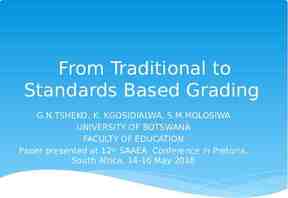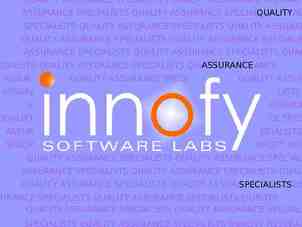A Feature-Based Analysis & Comparison of IT Automation
35 Slides94.85 KB
A Feature-Based Analysis & Comparison of IT Automation Tools: Comparing Kaseya to KACE KBOX Developed by: David Wong Robin Nadal
Overview Unlike other IT-management tools KACE makes efficient system management available by providing an appliance based architecture. KBOX physical features are very similar to a server, the user just have to connect it to the network, give it an IP address and is ready to start managing all the systems in the network. KACE offers two versions of its KBOX system, KBOX1000 and KBOX2000. The main difference between them is that K1000 is an agent based system and K2000 uses a network based system to manage machines.
Background Founders Marty Kacin and Rob Meinhardt founded Kace in 2003 with self funds and capital from Sigma Partners, Norwest Venture Partners, and Focus Ventures. In 2007 KACE expanded by acquiring appdepoy.com, Computers in Motion the next year and just recently Dell bought Kace in February 2010. Through KACE history the company has focus on appliance base management systems. KBOX systems has many integrated technologies from major partners like Bomgar, Mac, Microsoft, Citrux, Red Hat and many more. Kace offers a variety of options when it comes to educating customers, like white papers, webminars and most importantly a free virtual version of KBOX. Kace has a user base that includes government agencies and enterprise organizations from all round the world
OS Coverage Kace offers support for a wide variety of operating systems including Windows, Mac and Linux.
Grouping Managed Devices Grouping machines is one of the most important tasks for a system administrator which is why KBOX allow administrators to group machines dynamically. Dynamic grouping allows for monitoring, patch management, software distribution and configuration to be more efficient by grouping computers as targets using criteria such as hardware, software, network location, department and organization. For example you can set a criteria such that if a machine has a certain percent of its hard drive full to be dynamically added to a group that meets that condition.
Architecture KBOX architecture is divided in four layers to better provide functionality between the hardware, software, OS and agent environments. Each layer is design to take advantage of other layer’s features resulting in better use of resources and achieving better performance
Architecture Cont Layers : Application Services Management Services Platform Layer Distributed Management Layer
Architecture Cont Application Service Layer The application service layer is the interface between the user and the system, and is done through a web-based console. This console offers great flexibility for administrators by allowing access from any location with an internet connection, It's infrastructure consist of a very easy to use tabbed base interface that provides access to all the features and functionality.
Architecture Cont Management Services : In the management service layer the appliance based architecture automates many time costing tasks like patch management, logging, security logging, recovery and backup. It also monitors and conducts maintenance on hardware, storage and security components. One of the most useful features of the management layer is its self tuning procedures features and software upgrade system that allow easy upgrade of your whole system with the click of one button.
Architecture Cont Platform Layer: The platform layer consist of the hardware features of the KBOX, which includes multiple core processors with a pair of gigabit ports and a build in RAID system. It also offers the administrator a range of open source components that allow for a greater choice management software and optimization options.
Architecture Cont: Distribution Layer: K1000 uses an agent based architecture in order to deploy the system and all of its features. The way this work is that an agent containing all of K1000 features will be install on the system and then it will have constant communication with the KBOX. Before you can install the agents, identification of all available systems is done through a process call agent less scanning. Another alternative to install agents in a system is to download them directly from K1000 user portal and login scripts. Managing the latest version of the agent can be done easily trough an auto-upgrade feature.
Auditing and Asset Management KBOX uses a configuration management database to track computer and non computer assets like phones and other gear. Using the web interface you create assign and modify assets. Once an asset is created it is automatically integrated with KBOX functions like main inventory and help desk. Once an asset is rationalized the administrator can organize and associate the specific asset by vendor, contract, service and maintenance contracts.
Remote Control K1000 comes with a remote control functionality that allows direct access, and file sharing on systems on the network. Remote control can be configured to use UltraVNC which is bundle with K1000. Apart from the integrated remote control tool, K1000 also support integration with third party tools like NetOps, DreamWare, and Bomgar.
Automation The K1000 comes with a wide range of tools for automating and enforcing many tasks. Unlike other IT automation tools in the market K1000 is very flexible when it comes to scripting, by providing users an easy to use configuration policy that provides scripts for Windows, Mac and Linux. Each created script can be configured to one or many machines and groups. It also creates reports on for script status and alerts. Once a script is created it can be configure to be run only once or regularly.
Monotoring K1000 provide users the ability to monitor all aspects K1000 functionalities, from a machines hard drive to the expiration of a license. K1000 comes with a wizard reporting tool that lets you create or automate reports on aspects of your systems you want to monitor and give you the option to email these reports to the desired person, K1000 also let administrators use any third party ODBC compliant reporting tool. Apart from reports there are graphical reports that deliver up to the moment stratus of security, license compliance, clients and OSs.
Patch Management K1000 patch management solution is powered by Lumension, a third party patch management solution. The patch repositories support patches for Windows and Mac as well for a wide range of popular software like Adobe. Patch management scheduling can be applied to groups or individual machines regularly at different times. Patches can be filter by criteria using search capabilities and views given the flexibility to the administrators to have total control of the different patches he wants to apply. For patch monitoring K1000 comes with pre package reports or a custom report creating wizard that allow administrators to see the status of the patches or if they have rolled out successfully.
Backup and Disaster Recovery K1000 doesn’t offer an integrated backup and recovery solution but the new version K2000 does. K2000 comes with fail over and backup recovery that uses RAID configuration that provide hardware redundancy in case of catastrophe. It also gives users the ability to provide regular backups of the system state and configuration of their K2000 in case of data failure or loss. In addition K2000 provide an option to synchronize software assets with other K2000 boxes in other places which allows disaster recovery aid in different physical locations.
Security Security features in K1000 is integrated with all functionalities of the system, from patch management to computer inventory and all the systems administer by the KBox. For security K1000 offers a security and audit enforcement feature that helps identify security risks across all machines. Once vulnerability is detected it eliminates it, if by any reason the security vulnerability can’t be remove the infected machine will be quarantine from the network. Setting up a security policy and enforcing is done through security configuration policy enforcement feature that provide a number of pre built policies with a simple drop down options interface
Reporting The K1000 uses wizard based tools to accomplish reporting and is used to track the performance of service desk and respond to business needs. These wizard based tools easily create common and ad-hoc reports.
System Every organization has a database and is supported by this, this database contain user roles, passwords and permissions which guarantees that only approved administrators can access desired machines. Administrators also can classify administration domains according to the chosen scale of device control and under this module names, roles, descriptions, date of creation are assigned to organizations. Additionally, the settings found on K1000 offer the option of being controlled at an organizational point which allows arranging task achievement on desired organizations. In addition many organizations can be set up along with LDAP and machine filters to divide set of devices.
Usability The KACE 1000 provides a high level of usability. It is very easy to use which reduces training time, offers fast deployment and allows experienced and inexperienced technicians to administer the K1000. What’s more, the KACE K1000 gives administrator an integrated view, in which all IT management tasks area available, such as help desk, reporting, inventory, etc. This integrated view eases administration and reduces costs. Thanks to its familiar appearance and feel in its applications users learn quickly to use KACE K1000, thus it reduces the learning curve for everyone.
Reliability The KACE 1000 has an exceptional degree of reliability; it is a complete solution that provides a profound integration of messaging, hardware, distributed processing, and application functionality that allows the appliance based architectures to provide reliability to the highest level. The architecture enables maintenance, distributed automation and deployment of the solution guaranteeing reliable management operations
Performance The K1000 gets rid of the complexity and delivers high performance accomplishing IT operational tasks. Each layer works entirely with the purpose built in services of the adjacent layers, which maximizes performance. K1000 also uses very little client CPU phases and memory which permits to inventory and scan all clients frequently without affecting client performance.
Supportability K1000 supports both agent and agentless management in order to provide depth in management control and expansive visibility of all systems on a network. The K1000 agents support MAC, Windows, and Red Hat Linux systems. This is a great advantage since administrators have a complete view of all systems on a network despite the operating system. The K1000 architecture supports various agent requests at the same time, which allows K1000 to perform actions on the agents. K1000 also supports Microsoft BITS which is used for restarting and throttling file downloads if the links are slow. Moreover, K1000 supports technologies from the open source community ensuring the extra advantage of continuous evolution. What is more, reverse proxy is supported by K1000 allowing to put the K1000 behind its firewall and in an organization’s DMZ. DMZ is used to manage remote users that are not connected to the corporate network.








































